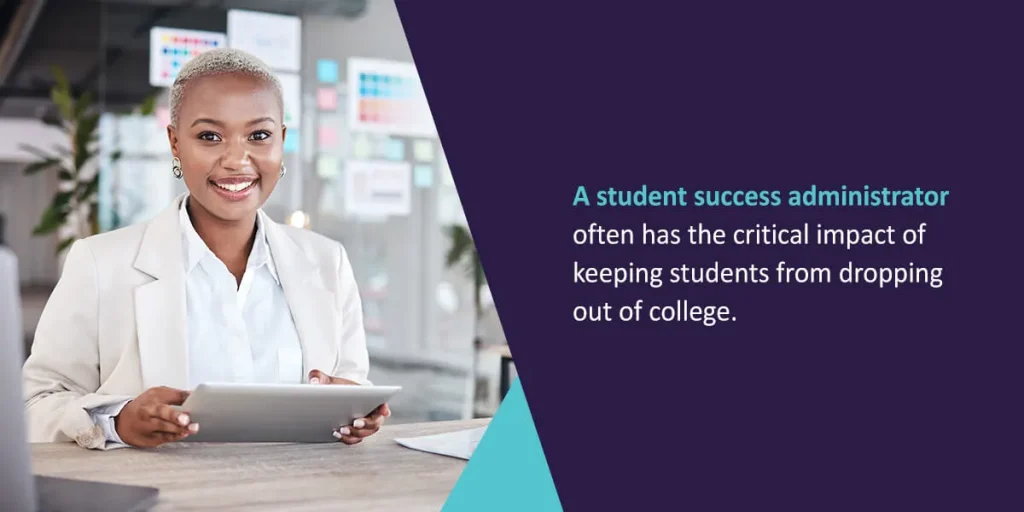




To make a higher education institution run like a well-oiled machine, you must pay attention to every moving part. From top administration to faculty and staff, each role within the college system is essential to its overall success. Perhaps one of the most vital roles within a higher education institution is that of the student success administrator. This individual weaves together the many aspects that impact student success, creating initiatives and interactions that support improved retention, post-graduation job placement, and other goals. Let’s take a closer look at this crucial role.
The Student Success Administrator oversees the student success program, identifies its priorities, and leads the student success team in its efforts across the broader campus. The fundamental role of the Student Success Administrator is to marshal data collected and set goals and priorities for student retention and success. They must also reorganize the current systems or implement new ones that will help the institution meet those goals.
The Student Success Administrator role is no small job. This person works with various people and departments and juggles an array of responsibilities. Some of the tasks that fall to a student success administrator include:
These requirements create quite a tall order! However, with so much responsibility comes considerable reach. Student Success Administrators and their teams have the power to advocate for the best, most proactive strategies to support students. They can make a significant difference in removing the financial, mental health, and academic roadblocks that students face.
Student success experts find that many campuses lack a cohesive, centralized office to review aggregated data from departments across campus, including enrollment, financial aid, advising, and academics. They miss out on the benefits of a holistic, integrated view of the entire school and academic affairs.
With these departments working individually rather than collaboratively, schools often struggle to identify and stem the tide of issues that may start in one area and flow into another. For example, a student with financial aid problems may have trouble completing coursework due to the time commitment of working. Additionally, faculty and administrators rarely know what issues students face outside of the classroom, making it difficult to properly identify and support underserved students.
In these cases, comprehensive data and analytics can play a big part in student, and ultimately institutional, success.
Early warning systems (EWS) that use predictive analytics allow student success administrators to anticipate issues on campus before they occur. They include two types of software:
Using known data about students allows the student success administrator and their team to determine which students might benefit from success coaching and identify what challenges a student could be facing.

A student success administrator often has the critical impact of keeping students from dropping out of college. Since 2015, dropout rates have either increased or remained steady for many schools in the United States. This information comes from the Education Data Initiative, a nonprofit organization dedicated to making data about the U.S. education system more open and accessible. Here are some other notable details their report offers about the significance of high dropout rates:
Research also tells us about the considerable impact of not having a college degree. The “college wage premium” refers to the higher wages earned due to having a higher education degree, and it can be significant. In a 2021 study, college graduates earned around $52,000 annually, while high school graduates made $30,000 annually.
How, then, do colleges and universities ensure the success of their students, given the challenges that students face, particularly underserved students, within and outside of the campus setting?
Higher education institutions are looking at new ways to retain their existing students. New technology and student data analysis offer more insight to higher education officials trying to support their overall population and at-risk students. These systems can highlight the ways students struggle to provide insight and guidance for developing better strategies and programs.
The student success administrator’s role is to put that data to use.
Student success administrators have many responsibilities and requirements, so knowing how to establish your program can streamline results for institutions and students.
Before implementing a successful student success program with administrators leading initiatives, your school must define what a successful student looks like on your campus. Student success will vary from institution to institution, depending on administrative priorities. These objectives might change over time as you try to improve various aspects of student life.
Some elements of student affairs your school can use to define student success include:
Your definition of student success provides a basis for the student success administrator’s responsibilities at your institution, offering more direction and focus. When your administrators know what student success looks like, they can better target students falling below the threshold and support students who are doing well.
A holistic approach to student success and equity is essential for solving the biggest problems colleges and universities face. Between keeping students engaged, increasing the chances of student success, and boosting student retention rates, you must consider a wide range of impacts.
A people, process, and technology (PPT) framework can help you find a student success administrator with the right breadth of experience to meet the institution’s goals. Consider their skill set in these areas:
Student success administrators with these skills can put them toward building a student success program that is accepted and successfully implemented campus-wide. Ultimately, it could lead to greater success ratios and higher returns on investment for the institution.
As you create your program, remember PPT principles to avoid tunneling on one specific component. They can help you maintain a holistic, well-rounded approach.
Because student success administrators must work with several different parties, accessibility and visibility are essential. Individuals must be accessible to other administrators, faculty, and students to streamline their responsibilities and effectively impact student success. This person must also share visible outcomes and actions with various groups to help the institution understand how the program functions and supports student needs.
For example, reporting back to other administrative teams and institution shareholders can ensure that student success administrators keep the school’s interests and priorities in mind. Meanwhile, publishing accomplishments and sharing new initiatives with students can help them feel supported and show campus-wide improvement.
As with every job, a student success administrator needs the appropriate resources. They’ll need a way to track student progress and overall performance to identify which students need help and in what ways. Software solutions can measure various student activities to help student success administrators access metrics they need to direct initiatives and interactions with students.
Further, you can convert data into records that help administrators track overall institutional progress. Access to historical data can show higher education decision-makers and investors how your student success administration program is helping students.
The right program for your institution should streamline the student success administrator’s workflow through automation and planning tools. Look for a system that integrates with all of your existing programs and uses a hands-off approach to data collection and analysis, allowing the team to spend more time interacting with students and working on initiatives.
A student success administrator can make a major difference in meeting goals related to retention, graduation rates, post-graduation placements, and other areas. This person can have a wide-reaching impact, but only if they have the right tools for the job.
Watermark offers several data tracking and management solutions for higher education institutions, including Watermark Student Success & Engagement. This solution tracks student performance metrics, like attendance, to help administrators identify at-risk individuals and tailor actions. The individuals working with students get alerts and can better respond to their needs.
Brunswick Community College is just one example of Watermark’s impact. The school’s president, Gene Smith, said, “Watermark has accelerated our focus on student success, and it has allowed for a valuable intersection between our faculty and staff, our processes and procedures, and our technology.” With the help of Watermark, Brunswick Community College has achieved an 82 percent graduation and transfer rate. This percentage is part of why they ranked as the nation’s number one community college in America for the second year in a row.
If you’re considering implementing a student success administrator in your institution, Watermark can help your team meet its goals and maximize impact for students. Request a demo today of Watermark and discover how it can transform your institution.






























































































































































































































































































































































































Submit this form to schedule a meeting with one of our reps to learn more about our solutions. If you need customer support instead, click here.

